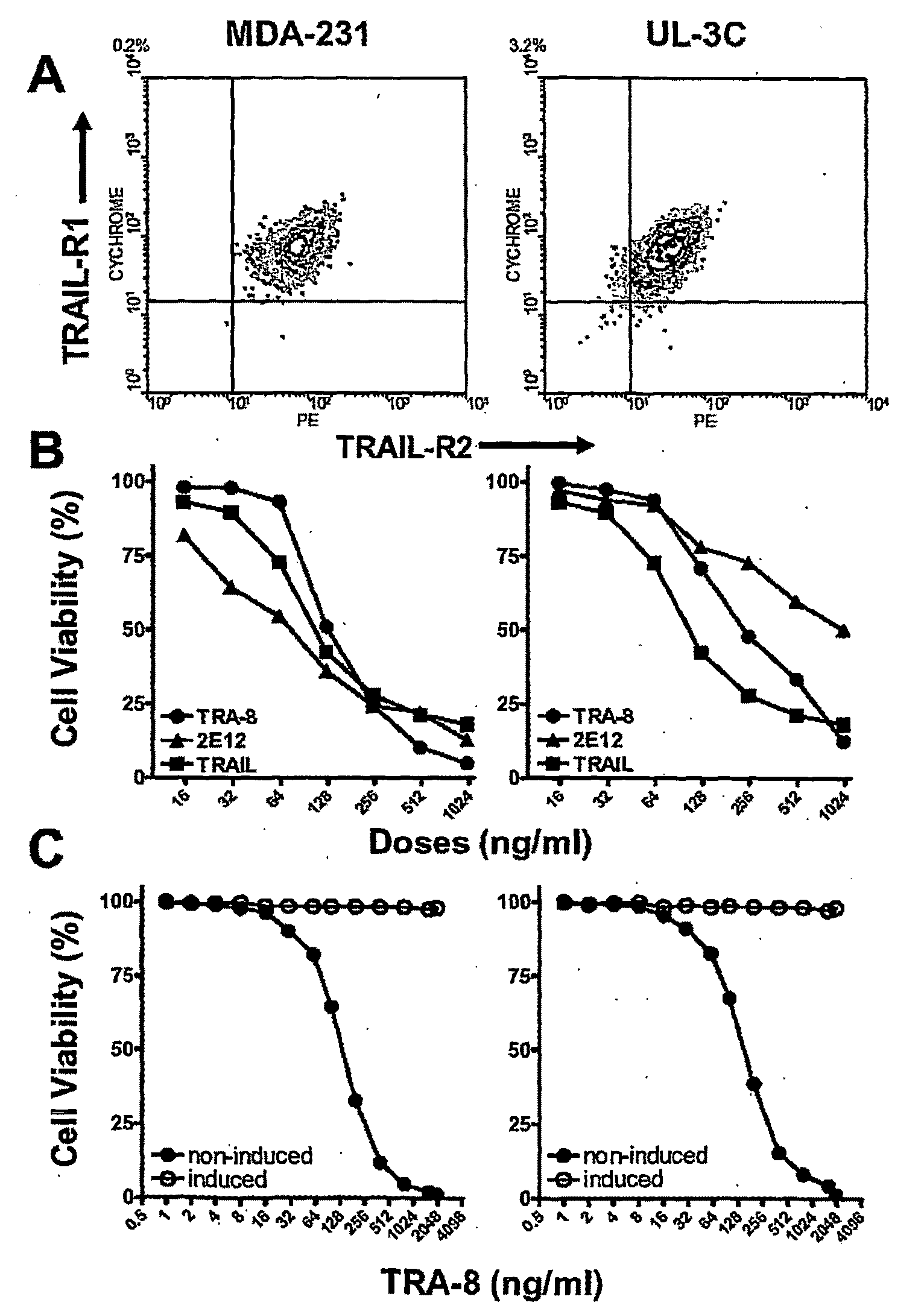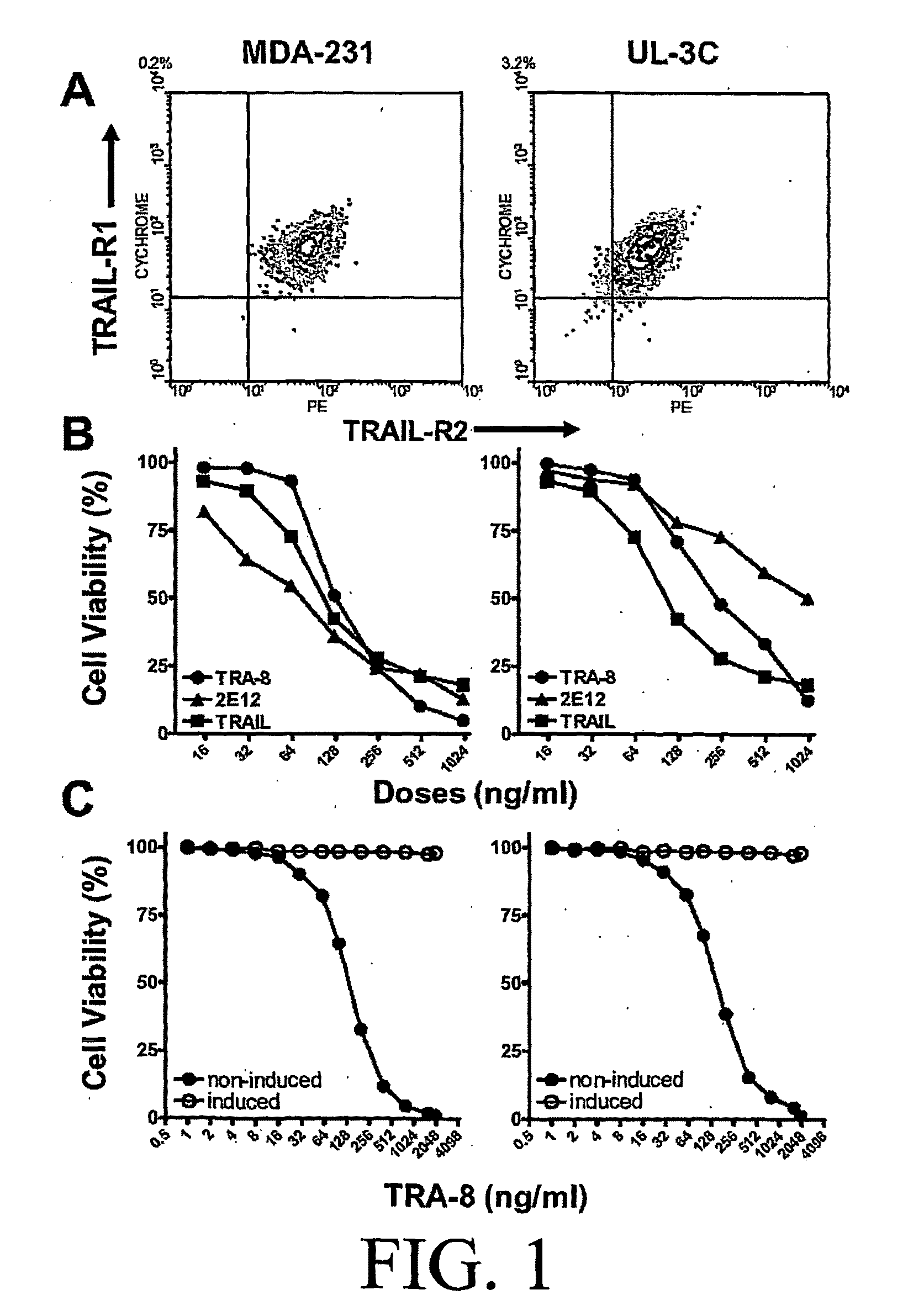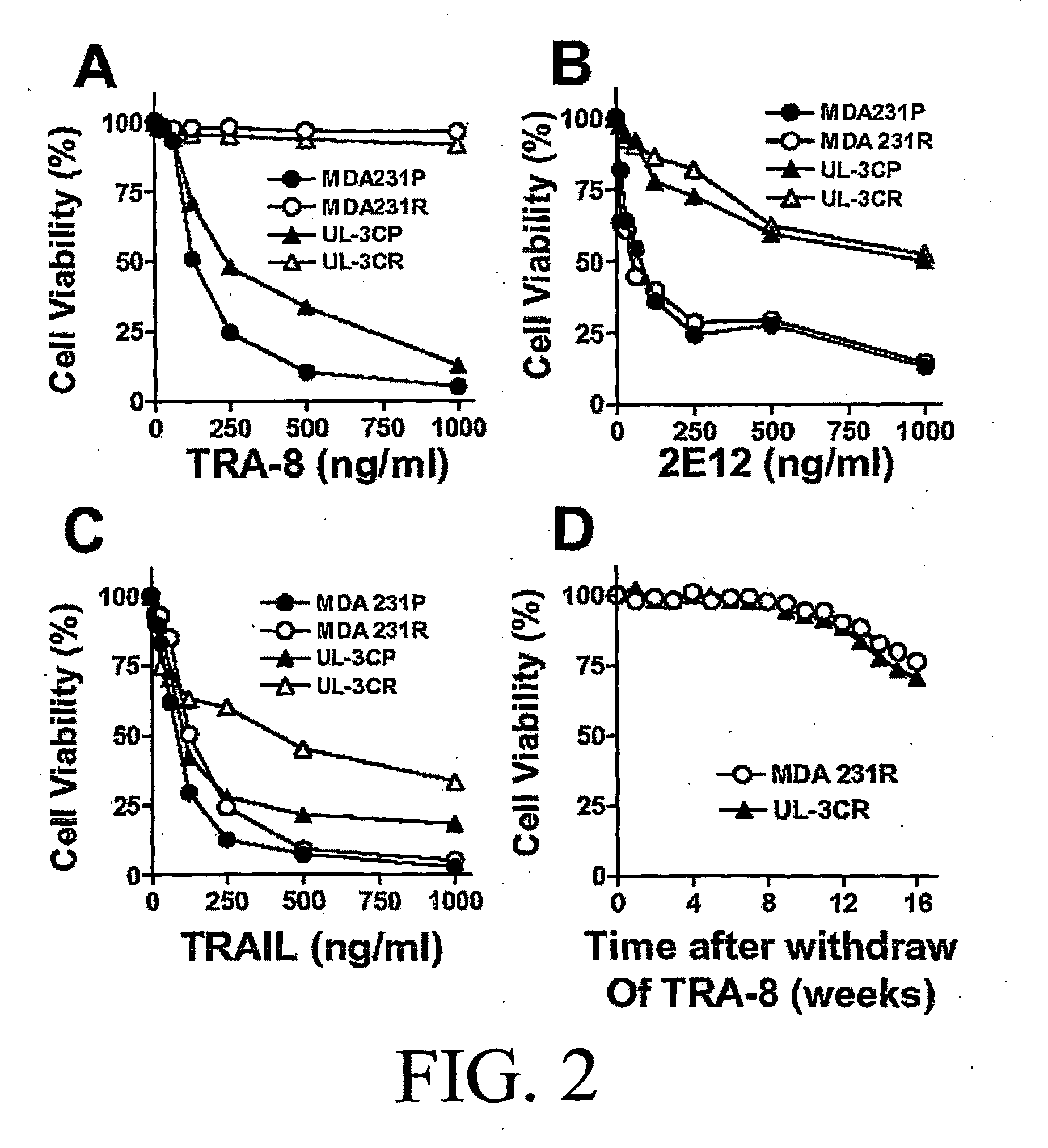Agents and Methods Related to Reducing Resistance To Apoptosis-Inducing Death Receptor Agonists
a technology of apoptosis and agonists, which is applied in the field of agents and methods related to reducing resistance to apoptosis-inducing death receptor agonists, can solve the problems that the expression of a death receptor by a target cell is not necessarily sufficient to make the cell susceptible to the induction of apoptosis by a ligand, and achieves the effect of reducing resistance to the death receptor agonist and reducing the resistance to the death receptor
- Summary
- Abstract
- Description
- Claims
- Application Information
AI Technical Summary
Benefits of technology
Problems solved by technology
Method used
Image
Examples
example 1
Inducible Resistance of Tumor Cells to TRAIL-R2-Mediated Apoptosis by Generation of a Blockade at the Death Domain Function
Materials and Methods
[0169]Cell Lines, Antibodies, and Reagents: Human breast cancer cell line, MDA-MB-231, was purchased from the American Tissue Culture Collection (ATCC) (Manassas, Va.). Human ovarian cancer cell line, UL-3C, was obtained. Cells were maintained in DMEM or RPMI1640 supplemented with 10% heat-inactivated FCS, 50 μg / ml streptomycin, and 50 U / mL penicillin (Cellgro, Mediatec, Inc., Hemdon, Va.). Anti-human TRAIL-R1 (clone: 2E12) and anti-human TRAIL-R2 (clone: TRA-8) monoclonal antibodies were previously described (Ichikawa, et al. 2003; Ichikawa, et al. 2001). Anti-human TRAIL-R2 (clone: 2B4) for flow cytometry and immunoprecipitation assays was developed. Recombinant soluble TRAIL was purchased from Alexis Biochemicals (San Diego, Calif.). Polyclonal anti-caspase 3 and anti-caspase 8 antibodies were purchased from BD PharMingen (San Diego, Cali...
example 2
Role of DDX3 in TRAIL-R2-Mediated Apoptosis
Materials and Methods
[0187]Cell Lines, Antibodies, and Reagents. Human breast cancer cell line, MDA-MB-231, was purchased from the American Tissue Culture Collection (ATCC) (Manassas, Va.). Human ovarian cancer cell line, UL-3C, was obtained. Cells were maintained in DMEM or RPMI1640 supplemented with 10% heat-inactivated FCS, 50 μg / ml streptomycin, and 50 U / mL penicillin (Cellgro, Medi-atec, Inc., Herndon, Va.). Anti-human TRAIL-R1 (clone: 2E12) and anti-human TRAIL-R2 (clone: TRA-8) monoclonal antibodies were previously described (Ichikawa et al., 2003; Ichikawa et al., 2001). Anti-human TRAIL-R2 (clone: 2B4) was developed for flow cytometry and immunoprecipitation assays. Recombinant soluble TRAIL was purchased from Alexis Biochemicals (San Diego, Calif.). Polyclonal anti-caspase 3 and anti-caspase 8 antibodies were purchased from BD Pharmingen (San Diego, Calif.). Monoclonal anti-human caspase 2, 3, 8, 9 and 10 antibodies, and monoclona...
example 3
Regulation of DDX3 Binding to DR5 by Serine Phosphorylation at a N-Terminal Region
[0214]Bioinformatics search led to identification of a serine-rich domain in DDX3 (SEQ ID NO:20, corresponding to amino acids 70 to 90 of SEQ ID NO:26) that is conserved for a potential substrate of GSK3 (FIG. 13A). Compared with f3-Catenin and glycogen synthetase which are two best substrates of GSK-3, DDX3 has five sequential serines N-terminal to the primed site. There are several lines of evidence supporting that DDX3 is a substrate for GSK3: (1) DDX3 is directly associated with GSK3α as demonstrated by co-immunoprecipitation of DDX3 with GSK3α and GSK3 is able to phosphorylate DDX3 (FIG. 13B); (2) GSK3 fails to phosphorylate DDX3 with a point mutation at Ser90 (FIG. 13C). (3) The Ser90 mutant DDX3 exhibits increased disassociation from DR5 and cleavage during TRA-8-mediated apoptosis (FIG. 13D). These results show that the serine-rich domain at the N-terminal of DDX3 plays a regulatory role in DDX...
PUM
| Property | Measurement | Unit |
|---|---|---|
| time | aaaaa | aaaaa |
| volumes | aaaaa | aaaaa |
| volumes | aaaaa | aaaaa |
Abstract
Description
Claims
Application Information
 Login to View More
Login to View More - R&D
- Intellectual Property
- Life Sciences
- Materials
- Tech Scout
- Unparalleled Data Quality
- Higher Quality Content
- 60% Fewer Hallucinations
Browse by: Latest US Patents, China's latest patents, Technical Efficacy Thesaurus, Application Domain, Technology Topic, Popular Technical Reports.
© 2025 PatSnap. All rights reserved.Legal|Privacy policy|Modern Slavery Act Transparency Statement|Sitemap|About US| Contact US: help@patsnap.com



